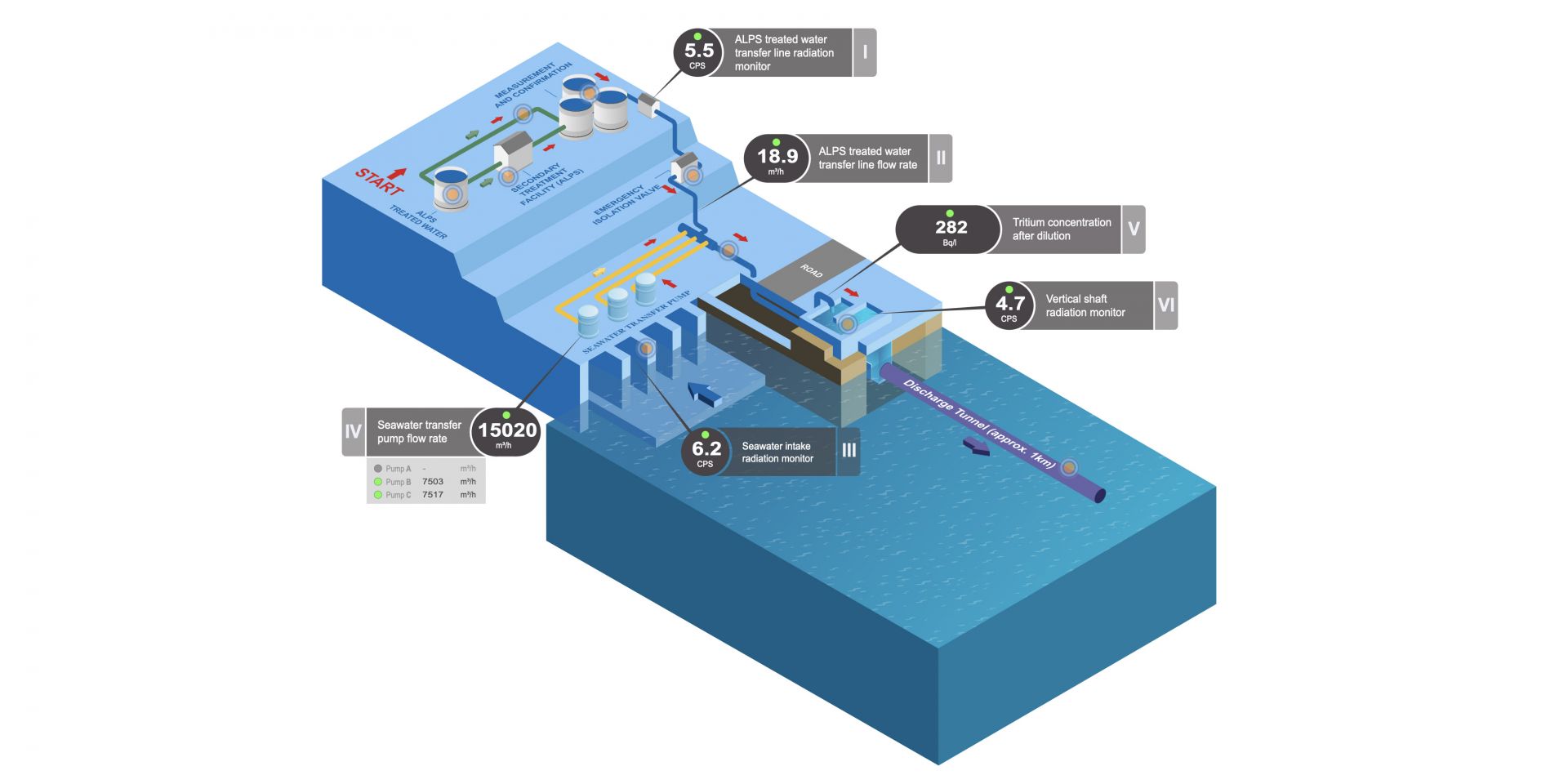Data from Fukushima ALPS-treated water discharge. (Image: IAEA)
An International Atomic Energy Agency task force has confirmed that the discharge of treated water from Japan's Fukushima Daiichi nuclear power plant is progressing in accordance with the plan approved by Japan’s Nuclear Regulation Authority.
An IAEA task force visited Fukushima in October 2023 to review the safety of TEPCO’s discharge of ALPS-treated water. (Photo: TEPCO)
International Atomic Energy Agency experts have confirmed that the tritium concentration in the fourth batch of treated water released from Japan’s Fukushima Daiichi nuclear power plant is far below the country’s operational limit.
March 1, 2021, 3:01PMUpdated August 25, 2023, 3:21PMNuclear NewsJohn Fabian The Fukushima Daiichi nuclear power station site. Image: Courtesy of TEPCO.
Earlier this week, Japan announced its intention to move ahead with its plan to discharge re-treated, diluted tritiated wastewater from the damaged Fukushima Daiichi Nuclear Power Plant into the ocean. This plan has been a topic of discussion--and for many a source of contention--since 2013. After a decade of talks, and with the endorsement of nuclear scientists, experts, and organizations around the globe, the time has come to act. By following safety standards in place and endorsed by the IAEA, the release of wastewater will pose no threat to the public or the environment.
The article below was originally published in the March 2021 issue of Nuclear News. (Also included in that issue is a great review article from Lake Barrett outlining the current status of the decontamination and decommissioning going on at Fukushima .) That month marked 10 years since the Tōhoku earthquake and tsunami devastated Japan and crippled the Fukushima plant. The words that follow remain timely, since various news outlets continue to report on the dangers of Fukushima's wastewater without providing context to the Japanese plan to discharge it.
Treated water is safer than world standards, essential for decommissioning
Washington, D.C. – The American Nuclear Society (ANS) supports the start of Japan’s controlled release of re-treated, diluted tritium wastewater into the sea from the Fukushima Daiichi Nuclear Power Plant (NPP), which sustained damage in the aftermath of a 2011 earthquake and tsunami.
A photo from 2021 of the Fukushima nuclear power station with the more than 1,000 water storage tanks on site. (Photo: TEPCO)
We’ve all seen the headlines such as “Should Japan Dump Fukushima's Radioactive Water into the Ocean?” along with “Japan Set to Pour Fukushima Waste into Pacific, Irking China” and “Japan Is Slowly but Surely Releasing Wastewater from the Fukushima Nuclear Plant into the Pacific Ocean.” The most recent spate of fearmongering was triggered by the IAEA’s July 4 announcement that the agency had finished its independent assessment of Japan’s plans to release the treated wastewater stored at the Fukushima Daiichi nuclear power station and found the plan “consistent with IAEA Safety Standards.”
The Neckarwestheim nuclear power plant in Germany. (Photo: EnBW)
German chancellor Olaf Scholz has provided what appears to be the final word on the fate of his country’s three remaining operating nuclear power plants.
Via an October 17 letter, Scholz informed economy and energy minister Robert Habeck, environment minister Steffi Lemke, and finance minister Christian Lindner of his decision to keep all three facilities operating “beyond 31 December 2022 until 15 April 2023 at the latest.” The order ends months of argument between Scholz’s two coalition partners—the stridently antinuclear Greens and the center-right Free Democrats (FDP)—regarding the plants’ continued operation. (Habeck and Lemke are Green Party members, while Lindner is with the FDP.)
The Neckarwestheim nuclear power plant in Germany.
For the few members of the nuclear community who haven’t already been made aware, the Wall Street Journal yesterday published a story headlined “Germany to Keep Last Three Nuclear Power Plants Running in Policy U-Turn.” According to the WSJ, the German government plans to postpone retirement of the plants—all of which had been slated for closure by the end of 2022—fearing an inadequate energy supply this winter.
NNSA administrator Jill Hruby (right) and Ken Nakajima, director of the Institute for Integrated Radiation and Nuclear Science at Kyoto University, in the KUCA control room. (Photo: NNSA)





.jpg)
.jpg)


 The International Atomic Energy Agency, for the second successive year, has revised upward its annual projections of nuclear power’s potential growth over the coming decades as an electricity provider.
The International Atomic Energy Agency, for the second successive year, has revised upward its annual projections of nuclear power’s potential growth over the coming decades as an electricity provider.


